The
majority of the Airfix vehicles are in 1/76 scale, although some are
meant to be placed near a 1/72 plane, so this kit looks to be in 1/72.
It gives us two trucks and a motorcycle. They are supplied as a RAF
airfield complement and you can find them also in the larger BOMBER
RE-SUPPLY SET with other items. Anyway, these vehicles were used also
by the army.
The grey plastic is soft and reacts very well to liquid cement. The
transparent sprue is made from a “glasslike” fragile plastic
and particular care is needed when cutting off the pieces. The moulds
are well done; flash free and the details are fine. The instructions
are simple and a colour profiles page is given apart. Sadly, no crew
figures are given. The decal set is thin and matt, the type I prefer.
Everything indicates that this is a good kit, and it is quite true.
I liked the kit so much, in the end I bought two…
Trucks are not as glamorous as tanks and good info is less available;
a little research however is due. At the end I found some helpful
information to make my models and to review the kit.
|
Bedford
MWC/MWD
This
truck was produced in quite a wide choice of specific uses:
MWD
– 15 cwt truck with GS body
MWC - Water tank truck
MWG – Self-propelled 20mm automatic gun
MWR - Radio truck
MWT – Antitank
MWV - Signals Van
MWK - Light Machinery
The
kit depicts a late type chassis. Two variants are given, the MWD 15
cwt GS and the MWC 200 gallons water truck. On the net there are a
lot of photos taken of restored vehicles. These can be used, but pay
attention because some restored vehicles are not historically correctly
or in post WW2 conditions.
This particular vehicle type, the 15 cwt, was called a truck. Heavier
vehicles were called Lorries. This difference is also noticeable in
the WD number prefix: Z for the trucks and L for the Lorries. If a
truck was a van the WD number prefix was V, if used as an artillery
tractor the WD number prefix was H.
The
scale model dimensions are quite correct. Some problems arose measuring
the model because I don’t always understand where the measurements
begins and ends (is there a towing hook? a spare wheel? and so on…).
I divided the Bedford truck review in three parts: the MW body, the
GS body and the 200 gallons body. Very useful photos of vehicle under
restoration can be found on hmvf.co.uk
site.
The kit
is quite well done and the only imprecision I’d find regards
the 15 cwt type (see below); there are some smaller ones (as in every
kit) which I ignored; anyway I felt some working was necessary to
have a more detailed model. Here’s what I did:
|
MW
Body
- An
engine is included, only to be hidden under the bonnet; however,
you now have the possibility to show it during maintenance or leave
off the bonnet sides, a practice often seen on desert pictures.
In this case, some extra detailing will be required.
- The
radiator mesh isn’t perfectly right: most of the photos I’ve
seen show it as a squared mesh fastened on the outside of the radiator
opening. Its reproduction in 1/72 is very hard to do because an
aftermarket PE mesh would hide the radiator opening (I tested it),
so I kept as it is and the model looks better.
- There
is a good amount of ejector pin marks to be sanded down here and
there. In some cases they need to be filled with a little drop of
cyanoacrylate glue. A patient check job is needed to find them.
Some pin marks are situated in the wood stripes engraving and those
lines must be re-engraved.
- The
gear lever stands up from an oversized squared hole. I closed it
with a thin plastic piece.
- The
handbrake near the gear lever is missing. I made it with some stretched
sprue segments.
- The
steering wheel rod is a bit short. It looks to be in a very unnatural
position for the driver having to stretch forward. I replaced it
adding the support plate using plastic sheet and stretched sprue.
- Behind
the passenger seat there was a stowage bin. I made it with plastic
sheet (it looks better with some soft items stowed inside).
- A
handle and a rounded tank were added in front of the passenger seat,
just to put something in the cabin, a little poor otherwise (adding
some personal item like helmets, backpacks, rifles and so on would
look better).
- Other
items that can be added are a fire extinguisher (the cylindrical
brass type) and two rifles with support, visible in the photos of
the restored vehicles. I saw these on some restored vehicles (although
not all of them) and I think they are correct. Anyway I choose not
to add them to my models until there’s more evidence.
- I
made the four towing points with metallic wire.
- On
the front mudguards top, two lights were reproduced with vertical
pins. I added some thin stretched sprue segment to have rounded
items (like the real lights) the rear was sanded down to have a
half egg shape.
- The
axle track dimensions are different from the front one. I didn’t
find their dimensions; anyway I have no reasons to think they are
not correct because other trucks had the same feature, for example
the CMP C15 rear axle track was 76 mm shorter than the forward one.
- The
wheels are already flattened where they touch the ground. They are
also a little bulged and in my opinion they look a bit deflated.
I sanded down the bulging to restore a normal section of the tyre.
Speaking of dimensions, they were of the 9x16 size. This means a
34” wheel diameter which means 12.0 mm in 1/72, as they correctly
are in this kit.
- The
front part of the fabric top was softened with cyanoacrylate glue
in the forward recessed part and sand paper on the corners. The
lower edge was thinned otherwise it hides the stowage bin. I removed
the hip ring: judging by the photos I’ve seen, it was not
so widely used and it seems only used in very late batches. The
rectangular hole needs to be closed with a piece of transparent
plastic. As per the windshield I’ll glue it in place after
having painted the vehicle.
- I'd
cut off the doors transparent parts, which weren’t glass windows:
they were made in soft plastic.
- If
visible (because not covered by the spare wheel or hidden by the
fabric cover of the GS body), the squared hole in the rear of piece
C19 needs to be closed. I did so for my MWC, and then I restored
the wood stripes engraving and removed the spare wheel support.
- In
the photos I’ve seen, the water truck MWC didn’t had
the bar with the towing hook at the end of the chassis. I'd cut
it off for my model.
- And
lastly, I made the mirror on the driver side with some thin stretched
sprue segment and a little plastic rectangle.
As already
told, the chassis is of the later type. Converting it in an earlier
type (always use a photo as reference) is quite simple: don’t
use the doors. They were made in some flexible fabric sheet and when
not used, were rolled and fastened to the piece C19 in place of the
two walls which need to be erased. The full windscreen used by the
mid 1943 must be replaced by two little glasses (called aero screens)
without the frame and hinged at the base. Both lights could be identical,
but the dashboard could be different.
For a vehicle produced before the mid 1940 the slots in the bonnet
sides need to be replaced by PE mesh.
Of course
the conversion in an early vehicle is a must for a model which depicts
a BEF or North African truck. However, some of these earlier vehicles
survived to be used in later campaigns as visible in some photos (see
for example IWM B10148 where both types are depicted together in Normandy).
The
kit gives us two rear bodies, so the spare one is useful for other
projects.
MWD
15 cwt GS body
The
MWD was the GS version truck, where GS means Generic Service. The
GS body was the same wooden type used also by other 15 cwt trucks
like the Morris CS8 and the Fordson WOT2. It was very similar to the
2A1 type used by the CMP cab 11 (both C15 and F15). The Airfix GS
body anyway it isn’t exactly correct. The rearward part is longer
than the forward one while in almost every photo I’ve seen the
sides were symmetrical. I didn’t find the original dimensions,
anyway the similar 2A1 body was 79”, 3/8” (28 mm in 1/72
scale). The GS body length reported in a forum (taken from a restored
vehicle) states it was 79”, ¼” (27.96 mm in 1/72
scale). The kit length is 29.5 mm so it should effectively be longer.
Correct or not, I shortened the body, visually the sides now are symmetric
and in my opinion the body looks better.
Adding
a plank per side to the modified body, fixed with three fittings,
the MWD body became the body for the MWR (but it will need the wireless
sets).
A MWD walk around is here:
http://www.net-maquettes.com/it/pictures/bedford-mv-15cwt-walk/
.
|
- On
the sides there are two supplementary walls. I didn’t find
evidence of these walls on the photos I’ve seen. I can only
think it is a specific modification by Airfix or a device of another
type of body (see below). Being not visible in the photos, I made
my model without them.
- I
kept the kit floor planks layout although in some photos the planks
look to be placed in a different layout.
- On
the floor under surface there are four ejector marks. Three of them
will be hidden by the fuel tanks and a box. I filled and sanded
down the last one.
- The
rear door is not symmetric. I don’t know if this is correct
(but I suspect it isn’t), however I left it as it is being
not so noticeable.
|
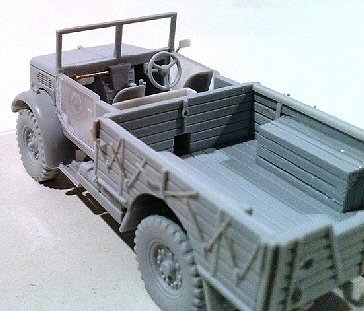 |
- The
GS body was made in wood. I engraved the wood stripes on the smooth
inner sides. If the body is left completely closed by the canvas
cover, this engraving job is not needed.
- The
wheelhouses are not rectangular, their correction is clearly possible,
but the thing is only noticeable if the canvas cover is not used.
Seen from the opened cover it isn’t and this being my choice
I left them as they are.
- For
the correct alignment of the sides C22/C23 and the rear B22 I used
slow drying glue to have the time needed to correctly place the
pieces, after having dry fitted the wheel cover boxes.
|
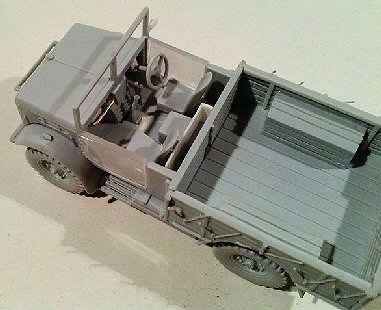 |
- The
fabric cover was kept in shape by a frame made of metal pipes. The
sagging cloth between these pipes looks wrong (because of the shortened
body) and has to be sanded down.
After having cleaned the inner side, the fabric cover lower edge
was thinned from the inside, and then I made the frame with metallic
wire and stretched sprue. The six pins hanging from the lower edge
of the cover were cut off and to make things easier, these parts
of the frame were made with stretched sprue segments glued to the
body sides repositioned to adapt to the new sides' length. The frame
was visible if the fabric was removed or if the rear was left opened.
Judging by the photos I’ve seen, while in the desert a lot
of trucks removed the cover altogether and sometimes even the frame;
in NWE the body was normally kept covered.
- The
cover was held in place by a wire that was made with thin stretched
sprue segments. The original wire went up and down, passing through
four little hooks on each body's side, in the middle the wire passed
under the central frame interlock. While gluing the segments, I
had to pay attention to replicate the effect (the upper end will
be glued to the fabric cover after the interior will be painted
and glued in place).
|
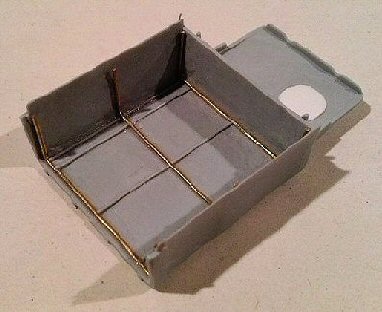 |
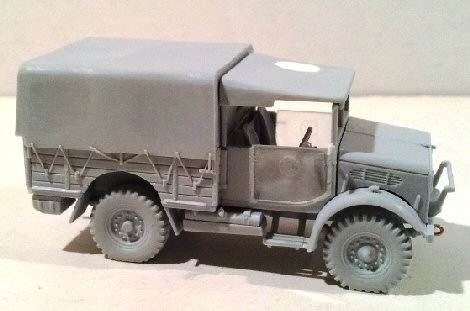 _____________ _____________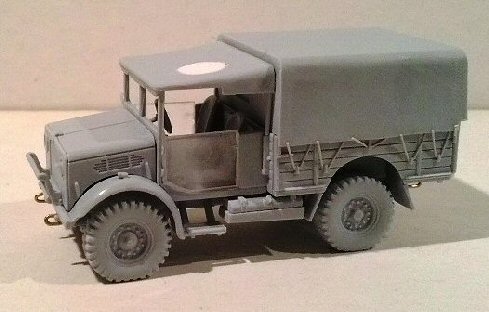 |
 _____________ _____________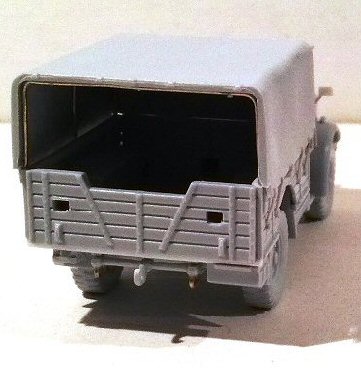 |
MWV
15 cwt GS
About
the GS body, as I mentioned earlier “almost every” because
the body replicated by Airfix was effectively used. You can see it
here http://www.mapleleafup.net/forums/showthread.php?t=14884
and here http://ww2talk.com/forums/topic/37910-bedford-census-number/
.
It was
the Bedford 'Van 15cwt. 4x2 GS'. The only batch (410 vehicles) I found
related to this type had the WD numbers V770401 to V770810. The first
vehicles produced had the bonnet mesh sides, while later ones had
the bonnet slots.
I planned
to make my second kit as a MWC water truck. However in my spare box
I had an unmade 1/76 Airfix Austin K6 left over from the emergency
kit, because the crash tender depicted is a post war civilian vehicle,
not usable in a WW2 contest. I noted that the chassis dimensions are
very compatible and after having cut the Bedford one to the required
length, with a bit of working on the available parts and some plastic
sheets/rods (and two little PE mesh for the bonnet sides) I found
myself with another Bedford MW early chassis (more or less). I choose
to make a 'Van 15cwt. 4x2 GS' by mating the new home made chassis
to the spare GS body. The GS body length was kept as it is. I like
to recycle and I consider this an interesting experiment.
I know
it is out of the review contest, so I mention this just to show the
difference between the two bodies.
|
|
About
the Van GS body these are the differences:
- The
frame interlocks on the body sides were absent so they were removed.
Where needed, I re-engraved the plank lines. A central fixing was
added with a thin plastic stripe.
- The
fabric cover was lengthened with plastic sheet, while the rear was
filed to make it vertical. The weaving pattern was sanded down.
- The
fabric cover was fixed permanently so, on the sides, the wires to
keep it in place were absent. The edges were sanded straight.
- I
don’t have idea about how the interiors looked like, so I
kept the fabric cover closed (not impossible in this case).
|
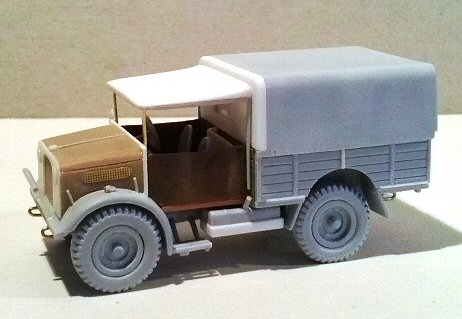 |
 _____________ _____________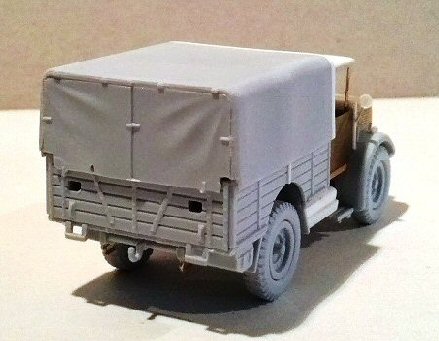 |
MWC
water truck
This
was the 200 gallons tank water truck. On the Bedford truck, two tank
types were used: an early type with an oval section and a later type
with the two vertical sides flat and the horizontal sides domed.
|
The
kit depicts the early type with the oval section. This tank was used
on both MW truck types (early and late). This tank type was also used
on the Morris truck. Having said this, I consider the model depicted
with the early tank on the late chassis as the mid production type,
the early type being the early tank on the early chassis and the late
type the late tank on the late chassis. Some useful photos are here:
http://www.maquetland.com/article-phototheque/3770-bedford-mwc-water-bowser-hendon. |
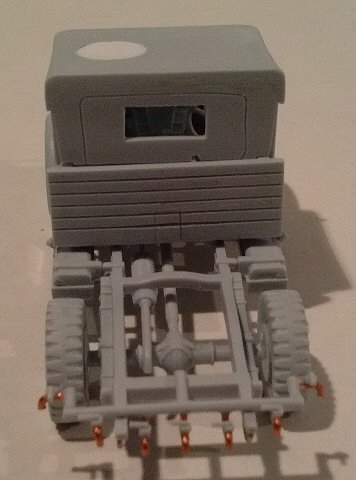 |
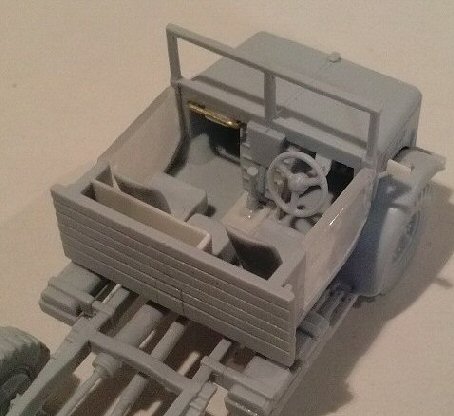 _____________ _____________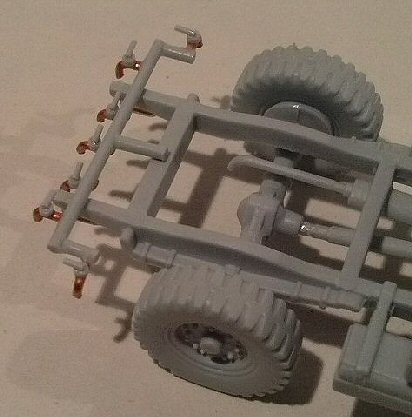 |
MWC
early tank
The tank
body is quite well done; the only really visible error is the height
of the lateral catwalks position, which needs to be lowered. This
correction apart, a minimum of detailing is needed.
|
- Carefully
cut off the top cap which was thinned and glued over a smaller disc
to have the correct “mushroom” shape.
- After
having cut them off, I repositioned the catwalks a couple of millimetres
lower, just above the line of the lower hinge.
- The
height of the boxes placed under the shelves was lowered consequently.
- The
supports which lean on the mudguards were steps. I cut them off
and made them with stretched sprue.
- The
mudguards rear ends were lowered with a piece of plastic shaped
in place.
|
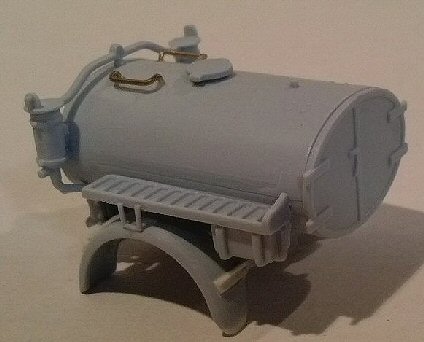 |
- The
mudguards frame was detailed with thin plastic stripes.
- On
the front side there were two steps. I made them with plastic.
- The
two reliefs looking like the squared parenthesis near the cap were
two handles, to make them more realistic I replaced these with metallic
wire.
|
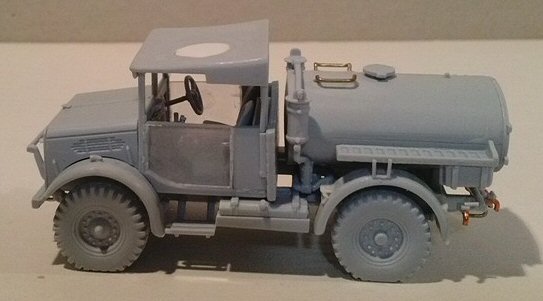 |
- The
piping which leads the water into the tank (B15) is a bit long;
I shortened it to 8mm.
- The
piping, which leads the water out of the tank, is missing. I used
stretched sprue to make the tube and metallic wire to make the taps.
Some system's variation on different vehicles can be found; anyway
most of the ones I’ve seen had the layout I made (which I
think was the standard).
|
|
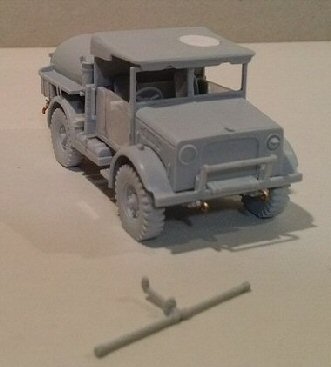 _____________ _____________ |
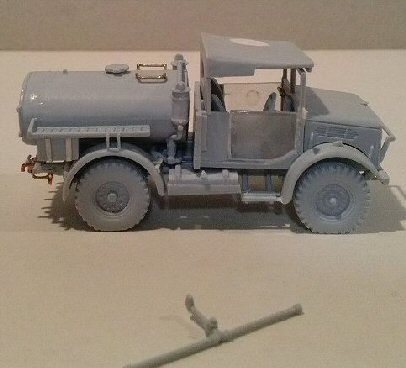 _____________ _____________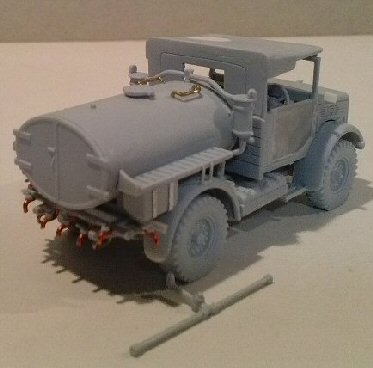 |
MWC
late tank
As already
told, I bought two kits. This leaves me with a second tank. I thought
to try the conversion into a late tank. I’ve seen photos of
this tank type only on the late MW truck. Useful photos can be seen
here: http://hmvf.co.uk/forumvb/showthread.php?15406-Bedford-MWC-66144-water-tank/page3
.
|
- I
carefully cut off the top cap which was thinned and glued over a
smaller disc to have the correct “mushroom” shape.
- I
removed the shelves and then I reduced the tank's width, flattening
the sides. I find the dimension scaling a 1/35 scale drawing and
it should be quite correct.
- The
rear doors hinges on the late version were attached on different
locations. So, I replaced them with thin plastic stripes, one just
above the upper hinge and one just below the lower hinge.
|
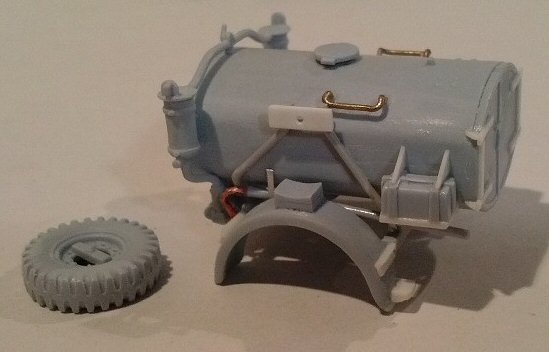 |
- The
mudguards rear ends were lowered with a piece of plastic shaped
in place.
- On
the left mudguard was the spare wheel base and on the right a generic
use base. Both were made with plastic.
- The
piping leading the water into the tank had a different layout; I
used stretched sprue and metallic wire to make it. They lay along
the tank sides fastened to two supports made with thin metal stripes.
|
 |
- With
two stretched sprue segments I made the spare wheel support.
- I
made new handles with metallic wire which were placed rearward the
upper cap.
- The
mudguards frame was detailed with thin plastic stripes.
- On
the mudguards there were two steps, I made them with plastic.
- Just
like the early tank, the piping which supplied the water is missing.
See above.
|
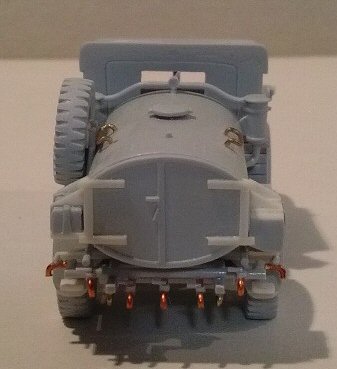 |
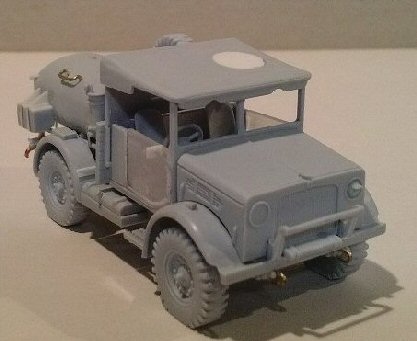 _____________ _____________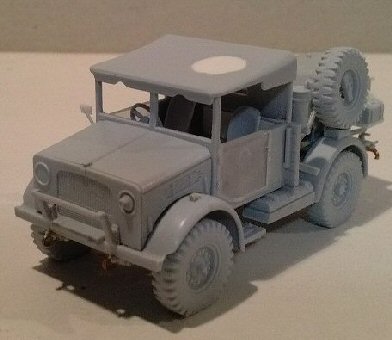 |
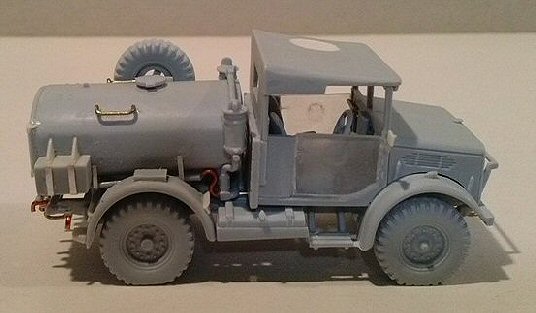 _____________ _____________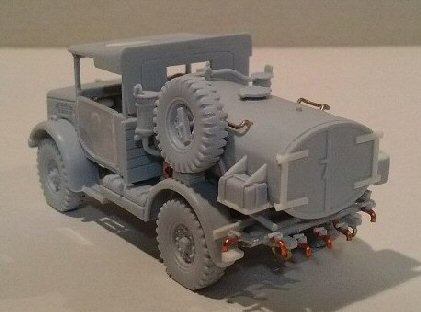 |
| Sometimes,
on the rear of the tank (in the very late batch I think) there were
two “horns” which supported a frame for a fabric cover as
for the GS MWD. I didn’t find information about its true purpose:
hiding the MWC identity or keeping the water fresh in the cover's shadow.
Anyway it wasn’t always present and I didn’t want hide the
tank, so didn’t add this detail. |
| Now
I only have to choose which one to use and which one has to go in the
spare box... |
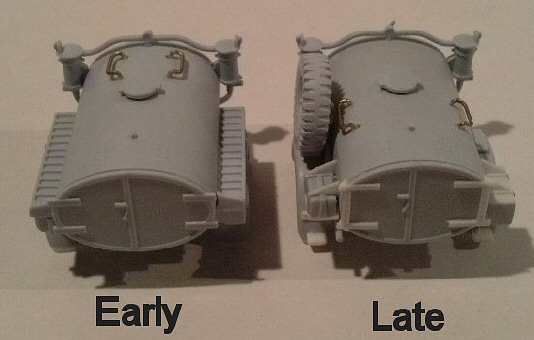 |
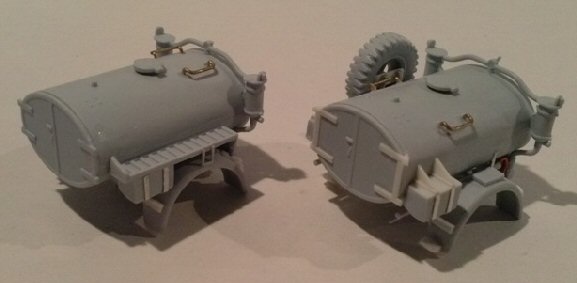 ______ ______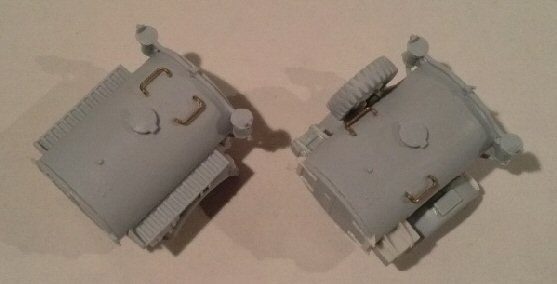 |
| Conclusions
In my
opinion, the MWD kit has a correct late MW body and a correct GS Van
body. The problem is that, until now I’ve seen GS Van bodies
only on early MW bodies. Having said this, the 15 cwt truck is well
done and the modelling possibilities are very wide. Since correcting
the flaws is very simple I consider this the possibility to choose
between two 15 cwt types working either on the MW body or on the GS
body.
Concerning the MWC, only the catwalks positions look really bad and
here also there is room for conversion. At the end I consider this
kit useful. Additionally let me point out that it was used in almost
every WW2 front and in the Korean War: captured Bedford trucks were
used in North Africa and German beute Bedford trucks were photographed
on the Russian front, making this a very interesting kit.
Preview
sample purchased by the author.
This
model can be purchased from

|










